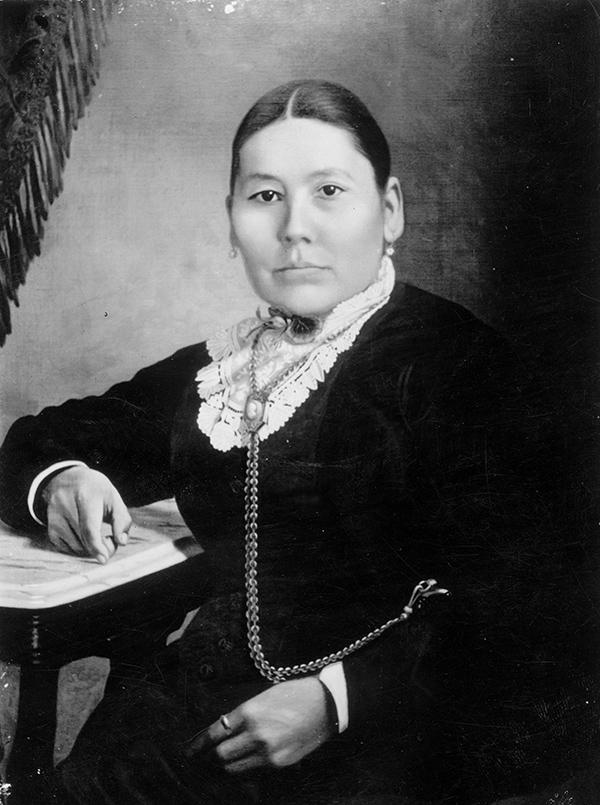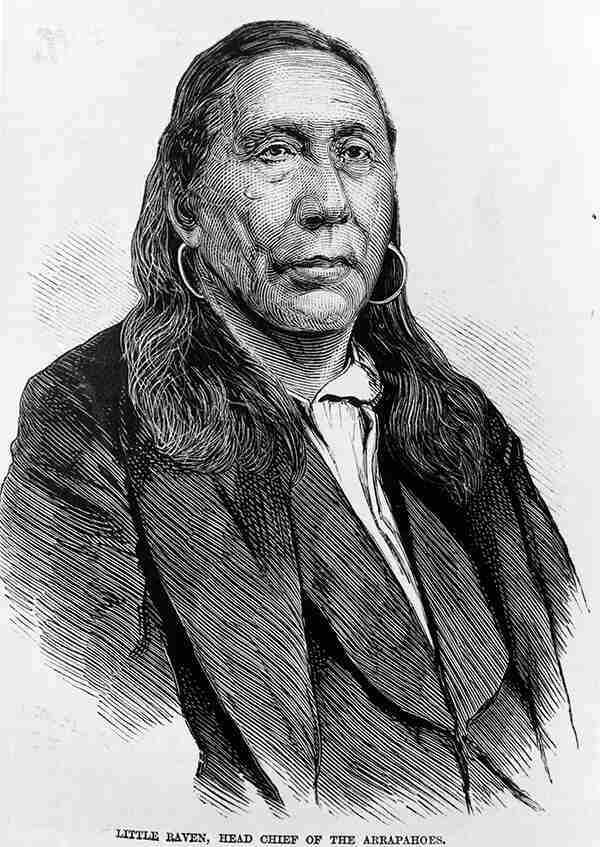Little Arkansas Treaty
Full Article
The Little Arkansas Treaty refers to a pair of treaties signed between the US and Indigenous nations in Kansas in mid-October 1865: one with the Southern Arapaho and Southern Cheyenne nations and one with the Comanche and Kiowa. Of the two, the treaty signed on October 14 with the Cheyenne and Arapaho, was the most significant within Colorado because it removed the two Indigenous nations to a new reservation in Indian Territory (present-day Oklahoma) and offered them reparations for the Sand Creek Massacre of the previous year.
The Little Arkansas Treaty remains contested today, as the Interior Department apparently mismanaged funds allocated for the reparations. Descendants of those killed in the Sand Creek Massacre have been fighting for these lost reparations throughout the twentieth century and into the twenty-first.
Origins
In February 1861, just two weeks after the US government established Colorado Territory, the Southern Arapaho and Southern Cheyenne signed the Treaty of Fort Wise. Representatives of both nations agreed to forfeit their bands’ land in northern Colorado and live on a reservation in eastern Colorado. Despite the treaty, episodes of white-Indigenous violence still occurred, so in September 1864, the Southern Cheyenne leader Black Kettle, among others, visited Denver to make a peace agreement with territorial governor John Evans.
In late November 1864, a group of several hundred Cheyenne and Arapaho, including Black Kettle’s band, camped at Sand Creek near Fort Lyon, along the boundary of the reservation. Believing themselves to be under the protection of the fort, the men left to hunt bison one morning and came back to a horrific scene—US troops under Colonel John Chivington had attacked the camp, slaughtering at least 230 women, children, and elders.
The Cheyenne and Arapaho retaliated over the next several months, burning ranches and other white settlements, including the town of Julesburg. After a lengthy investigation, the US government condemned the Sand Creek Massacre and decided to offer reparations to the afflicted parties in exchange for peace. In addition, with the end of the Civil War in 1865, the removal of the Cheyenne and Arapaho from Colorado was part of the government’s renewed focus on pacifying the indigenous population of the American West to make way for homesteads, railroads, mines, and cities.
Meeting on the Little Arkansas
To accomplish the joint goals of reparations and removal, the United States sent a treaty delegation—led by Colonel Henry Leavenworth and including Colorado notables Kit Carson and William Bent—to the banks of the Little Arkansas River, where they arrived on October 4, 1865. There the party waited until several Cheyenne and Arapaho bands arrived on October 11, with their numbers eventually totaling more than 4,000. Among them were Black Kettle’s Cheyenne and Little Raven’s Arapaho—both of whom had been at Sand Creek—as well as five other Cheyenne bands and six other Arapaho bands.
The treaty with the Cheyenne and Arapaho was concluded on October 14. In addition to calling for an end to hostilities between the parties, the treaty established a small reservation for both Indigenous nations in what is now western Oklahoma. However, the government had already removed other Native peoples to that area and would have to move them again to make space for the newcomers. Until then, the Cheyenne and Arapaho were allowed to “reside upon and range at pleasure throughout … that part of the country they claim as originally theirs, which lies between the Arkansas and Platte Rivers.”
In addition to annuities listed at twenty dollars per person for forty years, the Little Arkansas Treaty included reparations for the “gross and wanton outrages” of the Sand Creek Massacre. These included monetary reparations, as well as grants of 640 acres within the old 1861 reservation to members of affected families, including the Bent children and the extended family of John Prowers and his Cheyenne wife, Amache. The treaty also promised 320-acre grants within the new reservation to the leaders of bands killed at Sand Creek, including Black Kettle, and 160-acre grants to “each other person of said bands made a widow, or who lost a parent,” in the massacre.
Following the treaty with the Cheyenne and Arapaho—which was later amended to include a small number of Jicarilla Apache—a second treaty was signed with leaders from the Comanche and Kiowa nations on October 18.
Legacy
The American delegates at the Little Arkansas council were eager to acknowledge and make amends for the tragedy at Sand Creek, but the US government did not follow up on those promises. For one thing, the treaty’s promises to the Indigenous nations, while wholly justified, went beyond what was typical at the time and would incur costs that still had to be approved by the Senate. Samuel Kingman, an American observer at the council, noted that the Cheyenne-Arapaho treaty was “very liberal in its terms to the Indians, probably more so than will be sanctioned by the [S]enate.”
Still, in 1866 Congress appropriated $39,050 to cover the specific reparations outlined in the treaty. It is not known whether this amount would have been sufficient, but it did not matter; instead of issuing that money to the individuals listed in the treaty, the Interior Department gave some of the money to the tribes and, according to a modern legal assessment, “returned the rest” to the Treasury as “surplus.” The promised land grants did not materialize, either. The Medicine Lodge Treaties of 1867, which the government saw as a replacement for the Little Arkansas Treaty, did not address the missing Sand Creek reparations. By 1869 most of the Cheyenne and Arapaho had left Colorado for their new reservation in Oklahoma.
Descendants of the Sand Creek Massacre victims have long sought to reclaim the reparations listed in the Little Arkansas Treaty. Congress considered bills to pay out reparations in 1949, 1957, and 1965, but none passed. In 2013 Homer Flute, Robert Simpson, Jr., and Dorothy Wood—all members of the Sand Creek Massacre Descendants Trust—filed a lawsuit against the federal government to recoup the lost reparations. A district court dismissed the case, agreeing with US attorneys who argued that the government was no longer responsible for the reparations. The descendants’ lawyers had argued that a recent law did, in fact, allow their case to be heard, and they appealed to the US Tenth Circuit Court. In 2015, however, the appellate court affirmed the dismissal. In 2016 the US Supreme Court refused to hear the case, resulting in yet another denial of justice for one of the worst atrocities in American history.

































